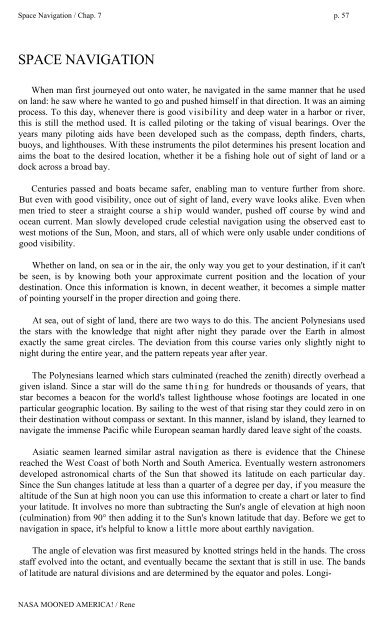Rene-NASA-Mooned-America
Rene-NASA-Mooned-America
Rene-NASA-Mooned-America
Create successful ePaper yourself
Turn your PDF publications into a flip-book with our unique Google optimized e-Paper software.
Space Navigation / Chap. 7 p. 57<br />
SPACE NAVIGATION<br />
When man first journeyed out onto water, he navigated in the same manner that he used<br />
on land: he saw where he wanted to go and pushed himself in that direction. It was an aiming<br />
process. To this day, whenever there is good visibility and deep water in a harbor or river,<br />
this is still the method used. It is called piloting or the taking of visual bearings. Over the<br />
years many piloting aids have been developed such as the compass, depth finders, charts,<br />
buoys, and lighthouses. With these instruments the pilot determines his present location and<br />
aims the boat to the desired location, whether it be a fishing hole out of sight of land or a<br />
dock across a broad bay.<br />
Centuries passed and boats became safer, enabling man to venture further from shore.<br />
But even with good visibility, once out of sight of land, every wave looks alike. Even when<br />
men tried to steer a straight course a ship would wander, pushed off course by wind and<br />
ocean current. Man slowly developed crude celestial navigation using the observed east to<br />
west motions of the Sun, Moon, and stars, all of which were only usable under conditions of<br />
good visibility.<br />
Whether on land, on sea or in the air, the only way you get to your destination, if it can't<br />
be seen, is by knowing both your approximate current position and the location of your<br />
destination. Once this information is known, in decent weather, it becomes a simple matter<br />
of pointing yourself in the proper direction and going there.<br />
At sea, out of sight of land, there are two ways to do this. The ancient Polynesians used<br />
the stars with the knowledge that night after night they parade over the Earth in almost<br />
exactly the same great circles. The deviation from this course varies only slightly night to<br />
night during the entire year, and the pattern repeats year after year.<br />
The Polynesians learned which stars culminated (reached the zenith) directly overhead a<br />
given island. Since a star will do the same thing for hundreds or thousands of years, that<br />
star becomes a beacon for the world's tallest lighthouse whose footings are located in one<br />
particular geographic location. By sailing to the west of that rising star they could zero in on<br />
their destination without compass or sextant. In this manner, island by island, they learned to<br />
navigate the immense Pacific while European seaman hardly dared leave sight of the coasts.<br />
Asiatic seamen learned similar astral navigation as there is evidence that the Chinese<br />
reached the West Coast of both North and South <strong>America</strong>. Eventually western astronomers<br />
developed astronomical charts of the Sun that showed its latitude on each particular day.<br />
Since the Sun changes latitude at less than a quarter of a degree per day, if you measure the<br />
altitude of the Sun at high noon you can use this information to create a chart or later to find<br />
your latitude. It involves no more than subtracting the Sun's angle of elevation at high noon<br />
(culmination) from 90° then adding it to the Sun's known latitude that day. Before we get to<br />
navigation in space, it's helpful to know a little more about earthly navigation.<br />
The angle of elevation was first measured by knotted strings held in the hands. The cross<br />
staff evolved into the octant, and eventually became the sextant that is still in use. The bands<br />
of latitude are natural divisions and are determined by the equator and poles. Longi-<br />
<strong>NASA</strong> MOONED AMERICA! / <strong>Rene</strong>


